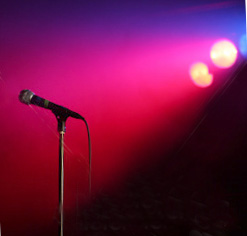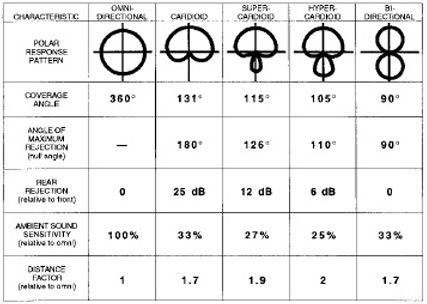
Two related types of unidirectional mics are supercardioid and hypercardioid.
Compared to a cardioid type, these have a progressively narrower coverage angle: 115 degrees for a supercardioid and 105 degrees for a hypercardioid.
However, unlike the cardioid, they have some pickup directly behind the mic. This is indicated in their polar patterns by a rounded projection, called a lobe, toward the rear of the mic.
The direction of least sensitivity (null angle) for these types is about 125 degrees for the supercardioid and 110 degrees for the hypercardioid. In general, any directional pattern that has a narrower front coverage angle than a cardioid will have some rear pickup and a different null angle.
The significance of these two polar patterns is their greater rejection of ambient sound in favor of on-axis sound: the supercardioid has the maximum ratio of on-axis pickup to ambient pickup, while the hypercardioid has the least overall pickup of ambient sound (only onequarter as much as an omni).
These can be useful types for certain situations, such as more distant pickup or in higher ambient noise levels, but they must be placed more carefully than a cardioid to get best performance.
What’s The Difference?
There are a few operational differences between omnidirectional and unidirectional mics. A useful feature of most unidirectional types is proximity effect.
This refers to the increased low-frequency response of a unidirectional microphone when it is placed closer than 1 or 2 feet to the sound source.
It becomes most noticeable at very short distances: a substantial boost in the bass response at less than 2 inches. In particular, for close up vocal use, proximity effect can add fullness and warmth to the sound and therefore may be desirable for use with some voices.
On the other hand, omnidirectional mics do not exhibit proximity effect and are less sensitive to wind noise and to handling noise. Most quality unidirectional types have effective built-in windscreens and shock mounts to compensate.
Selection, again, depends upon the sound source and the destination of the audio signal. For recording (but not sound reinforcement) of choral groups, orchestras, or even the congregation, an omnidirectional mic may be used to pick up sound from all directions rather than emphasizing individual voices or instruments.
However, as part of a sound reinforcement system, an omnidirectional may be more prone to feedback because it can’t be aimed away from the loudspeakers.
A unidirectional model not only helps to isolate one voice or instrument from other singers or instruments, but can also reject background noise. In addition, a properly placed unidirectional can minimize feedback, allowing higher sound reinforcement levels.
For these reasons, unidirectional mics far outnumber omnidirectional microphones in day-to-day use, in almost all church sound applications.
Tim Vear is a senior application engineer with Shure. He is noted for his teaching ability, presenting seminars about sound to a wide range of audiences and is the author of the Audio Systems Guide For Houses Of Worship.

